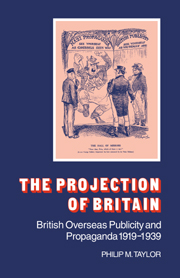Book contents
- Frontmatter
- Contents
- Preface
- Acknowledgements
- Abbreviations
- Introduction
- Part One Publicity and diplomacy, 1919–1939
- Part Two The projection of Britain, 1919–1939
- 3 Commercial propaganda and the concept of national projection
- 4 Cultural propaganda and the British Council
- Part Three Psychological rearmament, 1935–1939
- Conclusion
- Notes
- Select bibliography
- Index
3 - Commercial propaganda and the concept of national projection
Published online by Cambridge University Press: 01 October 2009
- Frontmatter
- Contents
- Preface
- Acknowledgements
- Abbreviations
- Introduction
- Part One Publicity and diplomacy, 1919–1939
- Part Two The projection of Britain, 1919–1939
- 3 Commercial propaganda and the concept of national projection
- 4 Cultural propaganda and the British Council
- Part Three Psychological rearmament, 1935–1939
- Conclusion
- Notes
- Select bibliography
- Index
Summary
If, on the return of peace in 1918, the British government proved reluctant to embark upon a programme of national propaganda overseas, it was, paradoxically, more prepared to undertake official propaganda at home. During the post-war period of social and economic dislocation, with its widespread strikes and disillusionment, it appeared to many officials and politicians that there existed a very real danger of insurrection and possibly even of revolution. Accordingly, during the 1919 railway strike, the Cabinet was prepared to authorise the use of posters, leaflets and press advertisements in an attempt to explain and clarify the government's position. As the number of strikes continued to increase, the Cabinet agreed, in April 1921, that it was of the utmost importance to take greater steps ‘to deal with the Government propaganda on a more elaborate scale than was at present in force’ to ensure that the public was being ‘correctly informed’ with regard to the main political issues. The Conservative Party was quick to learn the lessons of this experience, and by the mid 1920s it began experimenting with a small fleet of cinema vans which toured the country showing political films and cartoons. The Times noted in 1926: ‘The Conservative Party are now making use of the cinematograph regularly in propaganda work. Political propaganda seems to be the thin edge of the wedge, the other end of which may be national propaganda.’ And so it proved. In January 1935, Ramsay MacDonald's National Government established the National Publicity Bureau, which has been said to have ‘carried through the first modern, large-scale propaganda campaign on a national basis in the history of British politics’.
- Type
- Chapter
- Information
- The Projection of BritainBritish Overseas Publicity and Propaganda 1919–1939, pp. 83 - 124Publisher: Cambridge University PressPrint publication year: 1981



